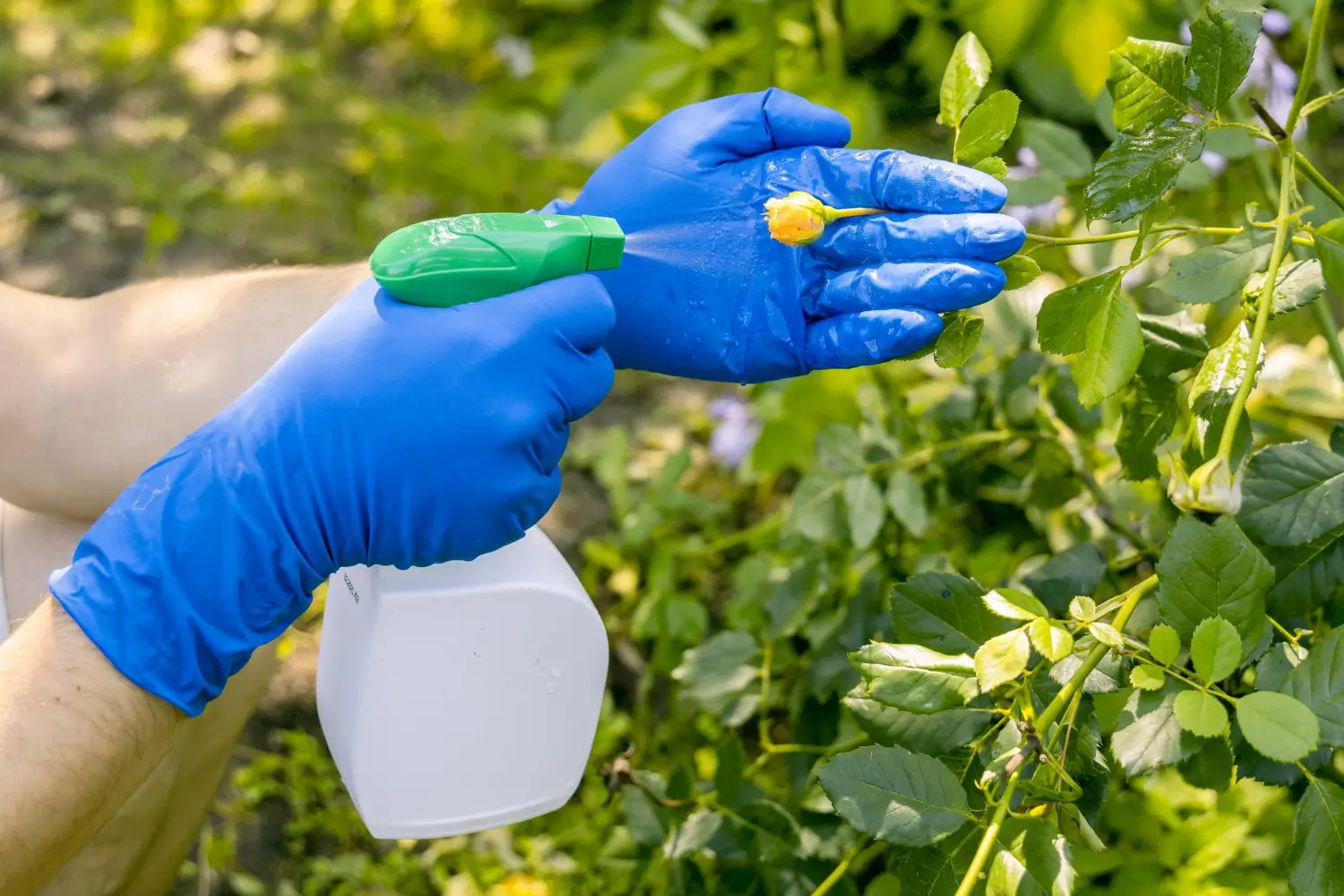
August 24, 2025

With so many pests that can damage plants and crops, pyrethrin insecticides are crucial for garden pest management.Synthetic pesticides have traditionally been used to control these insects; however, they can be toxic to the environment, harmful to beneficial insects, and pose risks to human health. An eco-friendly alternative is pyrethrin (derived from chrysanthemums), a natural insecticide.
Pyrethrin attacks the nervous system of insects, eventually causing paralysis and death. It works on aphids, beetles, and caterpillars. Compared to synthetic pesticides, pyrethrin causes relatively little harm to mammals, birds and beneficial insects when properly applied in the home or small-scale garden making pyrethrin an ideal pesticide choice for organic gardening.
Pyrethrin is a botanical insecticide made from the flowers of two types of chrysanthemum plants:
It is composed of a mixture of six insecticidal compounds:
Together, these compounds are toxic to invertebrates (pyrethrin is a somewhat broad-range insecticide), and pyrethrum is registered for such pests as:
Pyrethrin acts on the insect nervous system to kill insects. Pyrethrin's active compounds interact with sodium channels on insect nerves. Under normal conditions, sodium ions move in and out of nerve cells in a regulated fashion, transmitting electrical signals that direct movement and behavior.
Pyrethrin extends this process by forcing sodium channels to remain open longer, so that even more sodium ions pass through the cells. This disturbance with the normal electrical activity of the nervous system of the insect causes hyperexcitation and that results in a paralyzing effect on the insect. In this way, the affected insect will not be able to move, feed or do the other basic physiological processes that result in its death.
Pyrethrin acts quickly, and insects die within hours of contact. Pyrethrin acts fast, making it useful against pests that have a high reproductive rate and can do substantial foliar damage in no time.
Pyrethrin comes in two varieties that are used for pest control. While both are used for pest control, they vary in composition, environmental impact, and safety.
| Aspect | Natural Pyrethrin | Synthetic Pyrethroids |
|---|---|---|
| Composition | Derived from chrysanthemum flowers. | Chemically altered versions of pyrethrin. |
| Environmental Impact | Breaks down quickly; low environmental persistence. | More persistent; slower to break down, risk to ecosystems. |
| Safety | Low toxicity to mammals, but toxic to aquatic life and bees if misapplied. | More potent; can be toxic to mammals, birds, and beneficial insects. |
Pyrethrin offers a safe, effective, and eco-friendly solution for managing garden pests.
Here are three top pyrethrin-based products that stand out in the market for their reliability and effectiveness in pest management:
Monterey Take Down Garden Spray is a liquid concentrate containing pyrethrin paired with canola oil.
Another great way to control pests in the garden is Bonide 8oz Liquid Pyrethrin Concentrate.
In a commercial or greenhouse setting, the BASF Pyrethrum TR 2oz total release fogger is an effective resource for pest management. This fogger contains pyrethrins and piperonyl butoxide, a compound that increases the insecticidal activity of this toxin.
Safe use of pyrethrin in the garden is needed to keep it effective and yet minimize its impact on the environment, including beneficial insects and humans. Some do’s and don't for the safe and responsible use of pyrethrin in organic pest control are given below:
While Pyrethrin will kill a wide array of pests, excessive use invites trouble for the rest of the garden ecosystem (e.g., its non-target insects) and runs the risk of losing effectiveness over time. Save pyrethrin for if you have tried other, less toxic options without success.
Pyrethrin is a broad-spectrum insecticide that works on most common garden pests.
Aphids are small sap-sucking insects that, when feeding on plant fluids, can cause serious damage. They are also vectors of plant viruses, which cause stunted growth, curled leaves and poor flowering.
Caterpillars are notorious for eating just about all the foliage and fruits of plants causing extensive yield loss in various crops, most notably cabbage, tomatoes and pepper crops.
Whiteflies are minute bugs that feed on the sap of plants and fly. They weaken plants by feeding on their sap, causing leaves to yellow and distort. The honeydew they leave behind promotes mold growth, which can lead to more serious plant diseases.
These pests are known for the plant diseases they spread, such as phytoplasmas which cause leaves to wilt and turn yellow. They also harm plants by depriving them of essential sap.
These beetles feed on leaves and stems as they consume leaf tissue and can eventually defoliate and stress plants. They do the most damage to vegetables and ornamental plants.
Mealybugs are sap-feeding insects that secrete a grey-white powdery wax layer forming a sort of white and fluffy cocoon. It leads to the yellowing of leaves, wilting, and contributes to the growth of sooty mold.
Even though fleas and ticks are vertebrate pests, they can affect many ornamental plants because they carry diseases.
The efficacy of pyrethrin can be affected by many things in the environment. Learn how these factors affect the action of pyrethrin to ensure the best results.
Pyrethrin works best when applied at temperatures from 60°F and 85°F (15°C to 29°C). At these temperatures, pyrethrin can break down fast and work effectively on bugs.
Pyrethrin works best when applied in moderate humidity (40-60% relative humidity). The product has a longer life on the plant, which means more time to work on pests before it breaks down.
Pyrethrin is very susceptible to UV light. Pyrethrin has low persistence since it is easily degraded by direct sunlight. So, pyrethrin is best applied very early in the morning or late in the evening, with low sunlight present.
Pyrethrin's water solubility means that it is quickly diluted by rain, washing it off the surface and reducing its efficacy. To prevent this, apply the pyrethrin on dry days providing enough time for it to be absorbed and start working on pests before the rain hits.
Pyrethrin insecticides are a natural method of pest control for gardens. This natural repellent pyrethrin is extracted from chrysanthemums grown in various areas around the globe. It has been used safely for centuries to ward off insects that feed on crops such as aphids, beetles or caterpillars. Pyrethrin is just as useful when applied to ornamental plants or those grown for food, largely because it keeps gardens healthy and free from pests.
Growcycle is providing some pyrethrin products that are great for organic gardening and pest control. By making these products available, gardeners can choose just the right solution to keep their plants safe in an environmentally friendly way.
Disclaimer: This material is for informational purposes only and should not be relied on for legal, medical, financial, or any other form of professional advice.
Yes, Pyrethrin is safe for vegetable gardens. It is useful for the control of a range of garden pests and can be applied on the day of harvest, which makes it great for use in organic gardening practices.
While permethrin is synthetic, more persistent and will stick around longer in the environment, Pyrethrin is natural, biodegradable which makes it safer for the ecosystem and non-target organisms. Permethrin is long-lasting in commercial applications but pyrethrin is a better organic choice.
To eliminate a large number of garden pests like aphids, caterpillars, beetles and mosquitoes, the insecticide pyrethrin is created from chrysanthemums. It is also used in households and natural garden pest control.